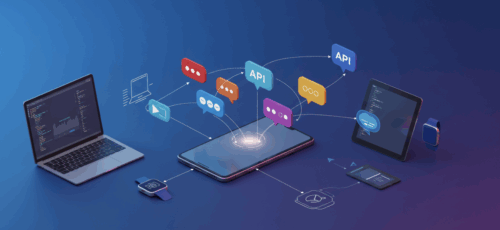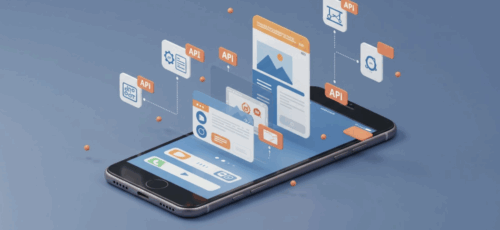Messaging API automation is transforming business communication with unprecedented efficiency and reach.
- The messaging API market is projected to grow at 18.9% CAGR through 2030.
- Advanced automation workflows enable personalized, real-time customer interactions across multiple touchpoints.
- AI-powered messaging and RCS technology are revolutionizing how organizations use business communication APIs.
Start automating your SMS and MMS strategies today to stay competitive.
Businesses rely on automated messaging to maintain meaningful customer relationships at scale. With SMS messages achieving a remarkable 98% open rate and 90% being read within three minutes, messaging automation has become essential for companies seeking reliable, immediate communication with their audiences.
SMS API automation is the evolution of business messaging from manual, one-off communications to sophisticated, trigger-based workflows that respond to customer actions in real time. Whether you’re building appointment reminder systems, authentication flows, or comprehensive marketing campaigns, understanding how to effectively leverage messaging and business communication APIs can improve both operational efficiency and customer satisfaction.
What is SMS API Automation, and How Does It Work?
SMS API automation refers to the systematic use of programming interfaces to automatically send, receive, and manage text messages based on predefined triggers, user behaviors, or scheduled events. Unlike traditional messaging approaches that require manual intervention, automation enables developers to create intelligent communication systems that operate seamlessly in the background.
These automated systems integrate directly with existing business applications, databases, and customer relationship management platforms to create contextual experiences. When a customer abandons a shopping cart, completes a purchase, or schedules an appointment, SMS automation workflows can trigger personalized text messages without any human intervention.
The power of messaging API automation lies in its ability to scale personal communication. A single business communication API can handle thousands of simultaneous conversations, ensuring every customer receives timely, relevant messages regardless of volume. Scalability makes API automation particularly valuable for businesses experiencing rapid growth or seasonal demand fluctuations.
How Automated Messaging Systems Process Customer Data
Modern SMS API platforms analyze customer behavior patterns, purchase history, and engagement metrics to determine the optimal timing and content for messaging. These systems can automatically segment audiences, dynamically personalize message content, and adjust delivery schedules based on individual customer preferences and time zones.
What are the Core Components of SMS API Infrastructure?
Messaging APIs consist of several key components that work together to deliver reliable automated communication. Understanding these elements helps developers build more robust and efficient SMS API automation systems.
How RESTful APIs Enable Messaging Automation
Most APIs follow REST principles, making them compatible with virtually any programming language or platform. This architecture allows developers to send HTTP requests with JSON payloads to trigger messages, check delivery status, and manage phone numbers programmatically. The simplicity of REST ensures that teams can integrate automation functionality without extensive specialized knowledge.
Webhooks in Business Communication APIs
Webhooks provide real-time communication between messaging platforms and business applications. When messages are delivered, replied to, or fail, webhooks immediately notify your systems, enabling instant response to customer interactions. This bi-directional communication forms the backbone of conversational messaging experiences and advanced automation workflows.
Message Detail Records Support Messaging API Analytics
Comprehensive logging through MDRs gives developers visibility into every aspect of message delivery within their SMS systems. These records include timestamps, delivery status, carrier information, and cost data, enabling teams to optimize messaging performance and quickly troubleshoot issues. Advanced communication APIs provide real-time access to MDRs through programmatic interfaces.
What are the Most Effective SMS and MMS API Automation Use Cases?
Businesses across industries leverage messaging API automation to solve specific operational challenges and improve customer experiences. Here are the most impactful applications developers commonly implement with SMS APIs:
How Appointment and Event Management Benefit from SMS API Automation
Healthcare providers, service businesses, and professional services rely heavily on automated appointment reminders to reduce no-shows and improve operational efficiency. Automation systems typically handle:
- Initial appointment confirmations sent immediately after booking
- Pre-appointment reminders delivered 24–48 hours in advance
- Day-of confirmations with location and preparation details
- Follow-up satisfaction surveys to automatically gather feedback
Smart appointment systems using APIs can automatically handle responses, allowing customers to confirm, reschedule, or cancel appointments by replying to text messages. This two-way communication reduces administrative overhead while providing customers with convenient self-service options.
Why Automation Is Critical for Customer Authentication
Multi-factor authentication (MFA) is one of the most impactful applications of SMS automation. Financial institutions, healthcare providers, and technology companies use automated messaging systems to instantly deliver one-time passwords (OTP) and verification codes. The immediate delivery and high reliability of business communication APIs make them ideal for security-sensitive applications where timing is crucial.
Advanced authentication workflows using API automation can adapt based on user behavior, sending additional verification challenges for suspicious login attempts or streamlining the process for recognized devices and locations.
How E-commerce Businesses Use MMS and SMS Automation
Online retailers and service providers use messaging API automation to keep customers informed throughout the entire purchasing journey. From order confirmations and payment processing notifications to shipping updates and delivery confirmations, API automation reduces support inquiries while improving customer satisfaction.
SMS campaigns see 21% to 32% conversion rates among mobile users, with abandoned cart recovery via SMS achieving 24.6% to 39.4% conversion rates. The most effective marketing automation combines SMS with other channels like email and push notifications, creating cohesive omnichannel experiences.
What Makes MMS API Integration Different?
While SMS API automation remains the foundation of messaging workflows, MMS API capabilities unlock new possibilities for visual communication. MMS messages can include images, videos, audio files, and interactive elements that enhance engagement rates compared to traditional SMS.
How Visual Customer Support Transforms Business Communication
Customer service teams increasingly use MMS API automation to handle visual inquiries and provide step-by-step guidance. When customers report issues with products or services, automated workflows can request photos for faster diagnosis and send visual instructions for resolution through integrated messaging systems.
MMS API in Product Marketing Automation
Retail businesses leverage MMS API automation alongside SMS to showcase new products, share styling tips, and provide visual proof of promotions. These rich media messages achieve higher engagement rates than text-only communications and can drive more qualified traffic to e-commerce platforms.
Advanced MMS API systems can automatically resize images, optimize file formats, and ensure compatibility across different devices and carriers, making visual messaging as reliable as traditional SMS.
What Trends are Shaping Business Communication API Development?
Messaging APIs continue evolving, with several key trends defining how businesses will implement business communication APIs.
How AI Is Transforming API Automation
Artificial intelligence integration within messaging platforms enables unprecedented personalization at scale through advanced SMS API automation. AI systems analyze customer data, interaction history, and behavioral patterns to automatically generate contextually relevant message content. These systems can adjust tone, timing, and content based on individual customer preferences and previous engagement patterns.
Machine learning algorithms continuously optimize API performance, testing different approaches and automatically implementing the most effective strategies for different customer segments.
RCS and Its Enhancement of Messaging API Capabilities
Rich Communication Services (RCS) technology brings app-like experiences directly to messaging applications, supporting interactive buttons, carousels, rich media, and branded sender identities. As RCS adoption increases across carriers and devices, businesses can create more engaging experiences without requiring customers to download additional applications.
RCS messaging maintains the reliability and universal reach of traditional SMS while providing the interactive capabilities traditionally associated with proprietary messaging platforms.
How Conversational Commerce Is Changing Communication APIs
The combination of messaging, AI, and e-commerce creates new opportunities for conversational commerce experiences powered by SMS API automation. Customers can browse products, make purchases, and receive support entirely through automated messaging workflows.
These systems integrate with payment processors, inventory management platforms, and customer service tools to provide seamless end-to-end transaction experiences without leaving the messaging interface.
Which Industries Benefit Most from Messaging API Automation?
Different industries have unique communication requirements that shape how they implement communication APIs. Understanding these sector-specific needs helps developers create more targeted messaging solutions.
How Healthcare Providers Use SMS API Automation Safely
Healthcare providers face strict regulatory requirements while needing to maintain efficient patient communication. HIPAA-compliant APIs enable secure appointment reminders, prescription notifications, and test result communications through carefully designed automation workflows.
These systems must balance automation efficiency with privacy protection and regulatory compliance, often requiring additional security features like end-to-end encryption and audit logging.
How Financial Services Automation Is Different
Banks and financial institutions use APIs for fraud alerts, transaction notifications, and account management communications. These applications require the highest levels of security and reliability, as customers depend on timely financial information for decision-making.
SMS automation in financial services often includes real-time fraud detection integration, multi-channel delivery options, and sophisticated failover mechanisms to ensure critical messages always reach customers.
Educational Institutions Implementing Messaging API Solutions
Educational institutions leverage SMS for enrollment confirmations, class reminders, grade notifications, and emergency communications. These systems often integrate with student information systems and learning management platforms to provide cohesive educational experiences.
What Technical Considerations are Essential for SMS Automation Success?
Successfully implementing messaging API automation requires attention to several technical factors that impact performance, reliability, and user experience.
How Carrier Compliance Requirements Affect SMS
Different carriers have varying requirements for automated messaging, particularly for marketing communications. Developers must implement opt-in management, content filtering, and frequency controls to maintain a good sending reputation and avoid service restrictions.
Understanding 10DLC registration requirements, toll-free messaging guidelines, and international regulations helps ensure SMS campaigns reach their intended audiences reliably.
Performance Optimization Strategies for Communication APIs
Effective SMS API implementations must handle variable message volumes without performance degradation. Developers must pay careful attention to API rate limits, connection pooling, and error handling strategies within SMS automation systems.
Implementing proper queue management and retry logic ensures messages are delivered even during peak usage periods or temporary service disruptions.
A Developer’s Approach to Integration Architecture for APIs
Successful SMS API automation depends on seamless integration with existing business systems. Developers should design flexible architectures that can adapt to changing requirements and integrate with multiple platforms simultaneously.
| Integration Component | SMS API Automation Considerations | Best Practices |
| CRM Systems | Real-time data sync, contact management | Implement webhook handlers, duplicate prevention |
| E-commerce Platforms | Order status triggers, inventory updates | Event-driven automation, error handling |
| Customer Support | Ticket creation, status updates | Two-way messaging APIs, escalation logic |
| Analytics Platforms | Message tracking, performance metrics | Data aggregation, dashboard integration |
How Can Businesses Ensure Security in SMS API Automation?
As automation handles increasingly sensitive customer data, security considerations become paramount. Developers must implement comprehensive protection measures throughout the entire messaging pipeline.
Encryption Standards in Communication APIs
All message content and customer data should be encrypted both in transit and at rest. Modern messaging APIs provide TLS encryption for data transmission and offer additional security features like IP whitelisting and token-based authentication for automation systems.
How Privacy Regulations Impact SMS API Implementation
GDPR, CCPA, and other privacy regulations impact how businesses collect, store, and use customer communication data through APIs. Automation systems must include consent management, data retention controls, and customer access rights functionality.
Authentication Methods That Work Best for API Security
Role-based access control ensures that only authorized personnel can access SMS functionality and customer data. Multi-factor authentication and regular access reviews help prevent unauthorized system access to business communication APIs.
What Advanced Features Enhance Automation Workflows?
Sophisticated messaging automation goes beyond simple scheduled broadcasts to create dynamic, responsive communication systems that adapt to customer behavior in real time.
Behavioral Triggers Improve Automation
Modern automation platforms enable complex trigger combinations based on customer actions, time delays, and external data sources. These systems can initiate SMS API automation sequences when customers:
- Visit specific web pages or product categories
- Open emails or click specific links
- Make purchases or abandon shopping carts
- Interact with previous messages or customer support
The Role of A/B Testing in APIs
Automated testing capabilities allow businesses to continuously improve messaging performance by testing different message content, timing, and frequency combinations through their systems. These platforms automatically route traffic to the best performing variants while maintaining statistical significance.
Cross-Channel Coordination Enhances Messaging API Effectiveness
The most effective automation strategies coordinate messaging across multiple communication channels. When SMS systems deliver messages, they can automatically adjust email timing, update social media advertising, and modify website personalization to create cohesive customer experiences.
FAQ
What are the main benefits of implementing SMS API automation for businesses? SMS delivers 98% open rates with instant delivery, making it far more effective than email or social media. It scales cost-effectively, reduces manual workload through automated workflows, and provides detailed analytics for optimization. Most importantly, it reaches customers on their most checked device, ensuring your messages get seen and acted upon.
How does MMS API differ from SMS API, and when should businesses use each? SMS API handles text-only messages up to 160 characters, while MMS API supports images, videos, and longer content. Use SMS for time-sensitive communications like authentication codes, alerts, and quick confirmations. Use MMS when visual content adds value, such as product showcases, visual support instructions, or document sharing. SMS wins on speed and reliability; MMS wins on engagement and context.
What compliance requirements should developers consider when implementing SMS API automation? Focus on consent management (TCPA compliance), 10DLC registration for business messaging, and privacy regulations like GDPR/CCPA. Implement clear opt-in/opt-out mechanisms, maintain audit logs, and follow carrier content guidelines. Healthcare and finance have additional requirements (HIPAA, etc.). Build compliance features into your SMS API integration from day one because retrofitting is much harder.
How can businesses measure the success of their SMS API automation campaigns? Track the essentials: delivery rates, open rates, click-through rates, and conversion rates. Monitor opt-out rates. Advanced metrics include customer lifetime value impact, response times, and cross-channel attribution. Most SMS APIs offer real-time analytics dashboards to automatically track these metrics.
Ready to Automate Your Business Communication?
SMS API automation changes how businesses connect with their customers, moving from reactive communication to proactive, intelligent engagement strategies. The combination of high reliability, immediate delivery, and sophisticated automation makes messaging APIs essential infrastructure for modern businesses.
Flowroute delivers enterprise-grade messaging API solutions backed by our patented HyperNetwork™ technology, ensuring your automated messages reach customers reliably every time. Our REST API, comprehensive documentation, and expert support team help developers implement powerful automation quickly and efficiently. Get started today to discover how Flowroute can power your next messaging automation project.

Mitch leads the Sales team at BCM One, overseeing revenue growth through cloud voice services across brands like SIPTRUNK, SIP.US, and Flowroute. With a focus on partner enablement and customer success, he helps businesses identify the right communication solutions within BCM One’s extensive portfolio. Mitch brings years of experience in channel sales and cloud-based telecom to every conversation.





